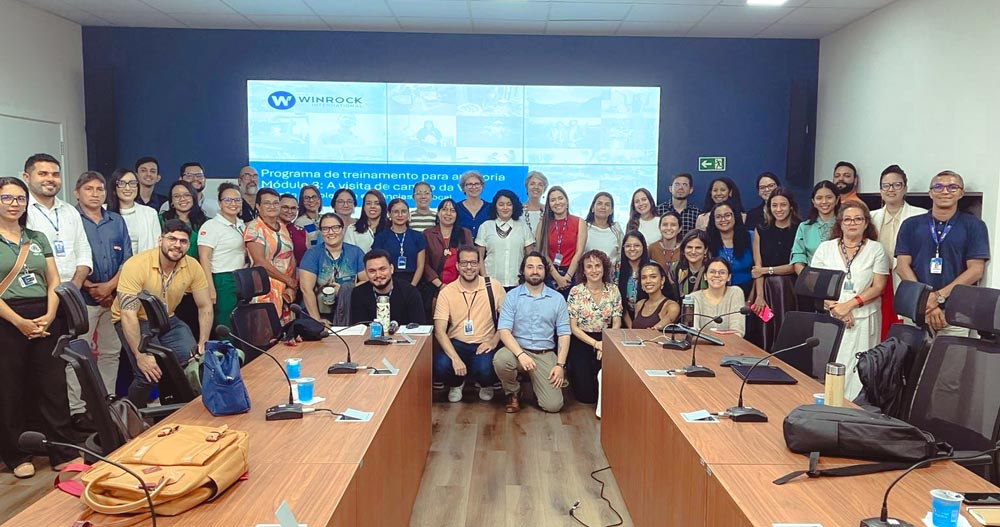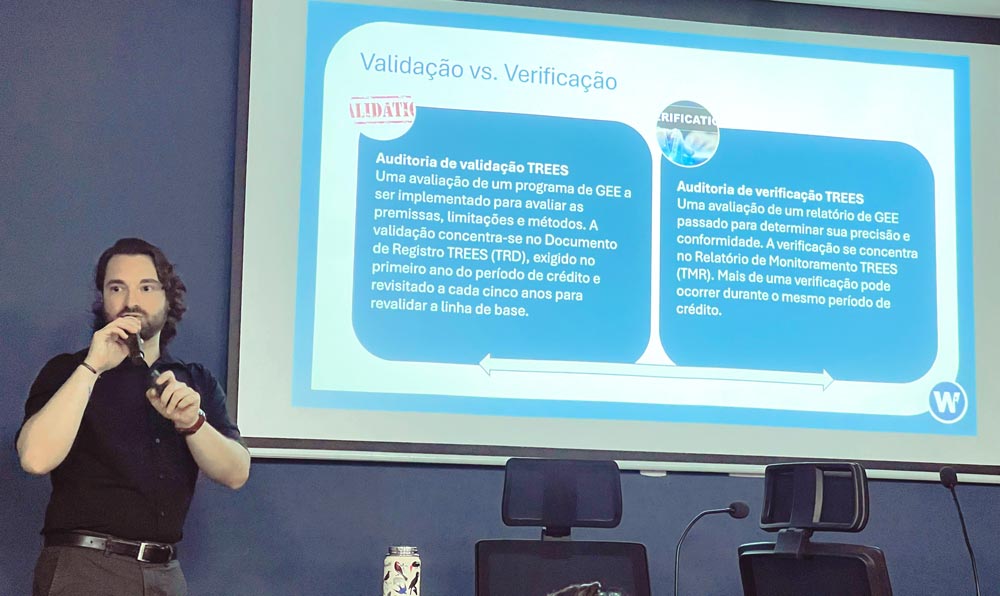The Climate Q&A with Pedro Piffer… Building capacity for Jurisdictional REDD+ programs in Pará, Brazil
Pedro Piffer, Winrock’s associate director of Ecosystem Services, is a land-use scientist with an extensive background in forest cover changes in tropical regions and their associated drivers. He holds a master’s degree in ecology from the State University of Campinas, Brazil, and a Ph.D. in ecology and evolutionary biology from Columbia University. His doctoral research focused on forest cover changes in Brazil, their effects on carbon sequestration, and impacts of land-use changes on the provision of ecosystem services in highly developed landscapes. He currently leads the implementation of Winrock’s portfolio of capacity building and technical assistance for Jurisdictional REDD+, having worked with REDD+ for over four years at both the project and jurisdictional scales.

Pedro, you recently led a training in Pará, Brazil. Can you give us an overview of it?
From August 4–8, 2025, Ecosystem Services conducted a training with the government of Pará focused on audit readiness and best engagement practices with Validation and Verification Bodies, also known as VVBs. This was in preparation for Pará’s first validation and verification process under the TREES program. The training was part of the UK-DESNZ-funded LEAF Technical Assistance program, which aims to provide forest jurisdictions with the technical support needed to ensure issuance of high-integrity carbon credits at the jurisdictional level.
Can you give us a quick explanation of what TREES is, what the LEAF Technical Assistance project is, and some of the other projects (and acronyms) you mentioned?
Absolutely. First, a quick note on “jurisdictions.” In this context, it refers to administrative areas like a state (sub-national) or even a whole country that is responsible for managing forests and implementing REDD+ programs. Working at the jurisdictional level — rather than just individual project sites — helps reduce risks like leakage, ensures coordinated policies and allows large-scale emissions reductions.
Now for the projects, (and all those acronyms):
- TREES is The REDD+ Environmental Excellence Standard, developed and operated by the Architecture for REDD+ Transactions (ART). It’s a rigorous framework that details requirements for jurisdictions to measure, report and verify reductions in greenhouse gas emissions from deforestation and forest degradation, as well as removals, environmental and social safeguards, and issuance of high-integrity carbon credits.
- LEAF Technical Assistance is a UK government–funded program delivered by Ecosystem Services and other partners that helps jurisdictions build the technical and institutional capacity they need to issue credits under the ART program and sell those to the LEAF Coalition — a global effort composed by private companies and governments to channel finance into forest protection.
- MRV stands for Monitoring, Reporting, and Verification, the backbone of credible carbon accounting (more on that later!)
- VVBs are Validation and Verification Bodies — accredited independent auditors who confirm that a jurisdiction’s data and processes meet the TREES requirements.
- And JREDD+ refers to reducing emissions from deforestation and forest degradation at the jurisdictional level, which means tackling deforestation and forest degradation at the scale of a whole state or country, rather than just through individual projects.
Why does this work matter in the big picture of tackling climate change and protecting the environment?
Forests are one of the most powerful tools we have to slow climate change. When jurisdictions like Pará can credibly measure and reduce deforestation, they’re not only reducing GHG emissions, but also protecting ecosystems that support biodiversity, safeguard water supplies and sustain local and Indigenous communities. By building the systems and capacity needed to verify emission reductions as required by TREES and issue credits for sale to the LEAF Coalition, jurisdictions can attract climate finance at a scale that makes forest conservation economically viable. That creates real incentives to keep forests standing — which is essential if we want to meet global climate and biodiversity goals.
In this context, the role of technical assistance, including the training we conducted in preparation for Pará’s upcoming audit process, is not only to ensure the success of the current jurisdictional program, but also to ensure future success.

Who did you collaborate with, and what was Winrock’s role in the training?
We partnered with Climate Law & Policy. Winrock’s Ecosystem Services team focused on technical topics related to MRV and carbon accounting, while CLP led sessions on social safeguards. Together, we provided a holistic view of what jurisdictions need to prepare for the TREES validation and verification.
Who participated in the training?
It was a broad group. Government employees from several divisions within the state of Pará government attended — the secretary of Environment, Climate and Sustainability; secretary of Indigenous Affairs; secretary of Infrastructure; secretary of Agriculture; and many others. Senior leadership, like the sub-secretary of Environment and the senior director of the State of Pará Environmental Assets Company, also participated. We were joined by technical partners such as the U.N. Development Programme, The Nature Conservancy, and the Amazon Environmental Research Institute, and even representatives of carbon credit buyers like Emergent (representing the LEAF Coalition). Attendance was strong, averaging 35 to 55 people each day.
What specific topics did the training cover?
We covered:
- Overview of GHG audits;
- TREES audit process;
- Data completeness and packaging;
- Planning and executing field audit visits; and
- Understanding audit (VVB) findings.
From our experience supporting other jurisdictions through the verification process under TREES, such as Guyana, we have found that strengthening capacity and knowledge on the process leads to more successful and timely audit outcomes. We also had open discussion sessions that allowed participants to raise questions beyond the agenda that included topics such as the scope of TREES documents, nesting, leakage, benefits sharing, remote sensing and carbon accounting methods, and many others.
Why was this training important for Pará right now?
Pará is preparing for a key milestone in the TREES process: its first validation and verification. That’s when an independent auditor confirms whether the jurisdiction is meeting TREES requirements and can issue verified carbon credits. Building jurisdictional staff capacity on both the technical and procedural sides is critical not only to ensure a successful audit outcome but also to create the foundations for a replicable process.
What was the outcome?
The activity was a clear success. Attendance was higher than expected and participants were very engaged. Feedback from the government indicated that the training was invaluable in building internal capacity ahead of the validation and verification milestone. By the end of the week, the jurisdiction’s readiness level had significantly increased.
In addition, many participants shared that not only was the training useful to provide a better understanding of GHG audits, but also it was helpful to receive a jurisdiction-specific, detailed and comprehensive overview of the TREES process, including its timelines, milestones and scope of its two main documents – the TREES Registration Document and TREES Monitoring Report. While Pará’s secretary of Environment and Sustainability leads the development of the state’s TREES program, it relies on the contributions from many other secretaries for the completion of their TREES documents. In addition to the active collaboration between their teams, many participants from these other secretaries expressed how our in-person engagement during my week there was helpful to provide them with a better understanding of the entire process as well as addressing their questions on other aspects of the program in addition to the audit.
Is Winrock planning to conduct related training in other locations, in the future?
Absolutely! Other members from our Ecosystem Services team conducted the same training with the Ministry of Environment, Water and Ecological Transition of Ecuador, the entity responsible for the development of Ecuador’s ART program. Similar to Pará, Ecuador is preparing for its first validation and verification, and our training proved to be a repeatable model that can be adapted to the specific context of each jurisdiction. Our plan is to conduct this training with several other jurisdictions that we support as they approach this significant milestone.
In addition, under this program, we have developed and applied training courses on other key topics with the several forest jurisdictions that we support such as: 1) project nesting in jurisdictions; 2) double-counting risks assessments; and 3) fundamentals of MRV and carbon accounting for JREDD+ programs. Finally, our Ecosystem Services team has also been actively sharing the lessons learned from our work supporting over 10 jurisdictions with their TREES document submissions at panels and meetings during major events in our field, such as the annual U.N. Conference of the Parties (climate change conferences) and Climate Week NYC.
